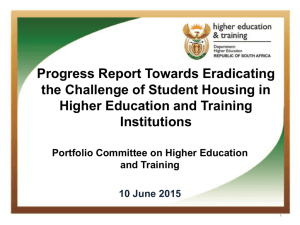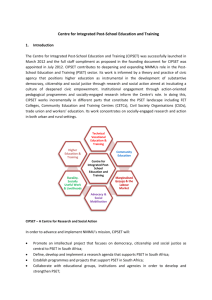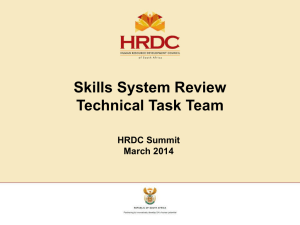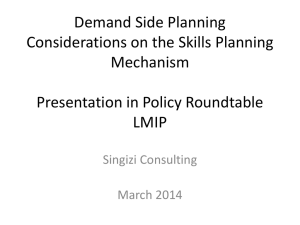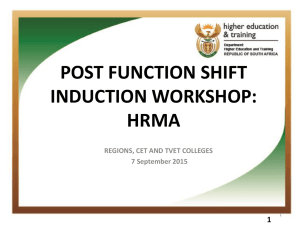The Department of Higher Education and Training is responsible for all
advertisement
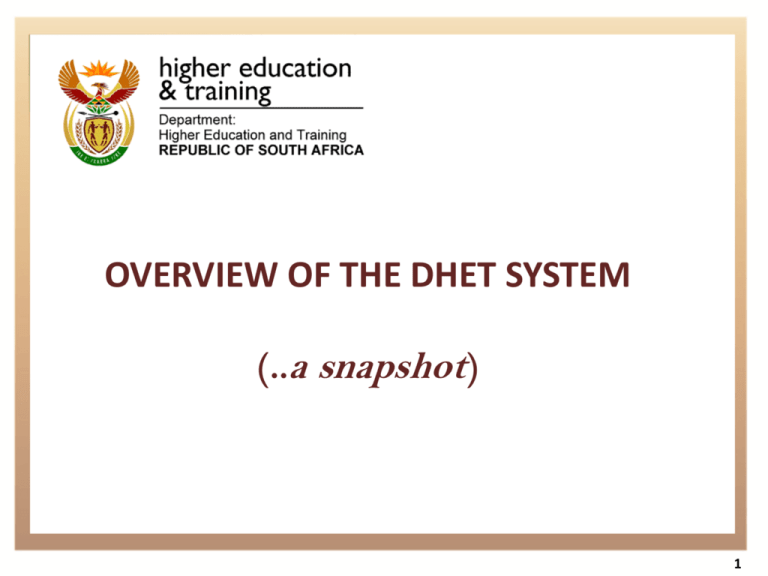
OVERVIEW OF THE DHET SYSTEM (..a snapshot) 1 Presentation Outline • • • • Overview of the DHET and its Mandate Programmes Architecture Strategic goals Values 2 DHET Overview and Mandate (1) May 2009 DHET formed On the demand side: The - Ensure that the skills needed to drive our Constitution of country’s social the Republic of economic growth All post and school development is delivered at an increasing rate SA Act, 1996 education and of quality skills will enhance SectionAvailability 29, read training both investment and service delivery with Schedule 4 Vision & Mission Vision Leading Post-School Education and Training for growth 5 Medium Term Strategic Goals Mission On the supply side: DHET is Serve a growing number of adults responsible for: - youngLegislative people and Framework: -Public Provide different entry points into and Universities; 1. Higher Education Act (HE pathways through the learning system Private Higher Education Act) - Institutions; Ensure quality learning wherever learning 2. National Student Financial Technical and Vocational takes place Aid Scheme Act (NSFAS Act) Education Training across the 3. Continuing Education and - Easyand pathways different learning Colleges; Training Act (CET Act) sites Private Colleges (registration and regulation) Community Colleges; SETAs; NSF NQF & SAQA; CHE & QCTO; NSA, and HRDSA 4. 5. 6. 7. To provide national strategic leadership in support of an integrated Post-School Education and Training system towards improved quality of life of the South African citizenry 5 Programmes National Qualifications Framework Act (NQF Act) Skills Development Levies Act Skills Development Act White Paper for Post-School Education and Training, 2013 3 DHET Overview and Mandate (2) • The Department of Higher Education and Training is responsible for all post-school education and training in the country • It is the coordinating Department for Outcome 5 of government’s 14 outcomes “A skilled and capable workforce to support an inclusive growth path” • In 2014, the Department released a White Paper for Post-School Education and Training (PSET), 2013 • The White Paper has created a framework that defines the Department’s vision for PSET, its focus and priorities • New Strategic Plan covering the period 2015 to 2020 • The strategic plan is informed by the vision espoused in the National Development Plan, the 2014 - 2019 Medium Term Strategic Framework (MTSF) and imperatives of the White Paper 4 Programmes Architecture (1) • The Department has 5 funded programmes (branches) i.e. • Programme 1: Administration • Purpose: provides strategic leadership, management and support to the Dept. • 6 sub-programmes i.e. the Ministry; Management; Corporate Services; CFO; Internal Auditing; and Office Accommodation • Programme 2: HRD, Planning and Monitoring Coordination • Purpose: provides strategic direction in the development, implementation and monitoring of departmental policies and the HRDS-SA • 6 sub-programmes i.e. Programme Management; HRD, Strategic Planning and Coordination; Planning, Information, Monitoring and Evaluation Coordination 5 Programmes Architecture (2) • Programme 3: University Education • Purpose: Develop and coordinate policy and regulatory frameworks for an effective and efficient university education system. Provides financial support to universities, NSFAS • 6 sub-programmes i.e. the Ministry; Management; Corporate Services; CFO; Internal Auditing; and Office Accommodation • Programme 4: VCET • Purpose: Plan, develop, implement, monitor, maintain, and evaluate, national policy, programmes, assessment practices and systems for college sectors (TVET and CETC) • 4 sub-programmes i.e. Programme Management; Planning and Inst Support; Programmes and Qualifications; and National Examinations and Assessment 6 Programmes Architecture (3) • Programme 5: Skills Development • Purpose: Promote and monitor the national skills development strategy. Develop a skills development policy and regulatory framework for an effective skills development system • 4 sub-programmes i.e. the Programme Management; SETA Coordination; National Skills Development Services; and Quality Development and Promotion 7 2015-2020 Strategic Goals • 5 strategic goals with 24 key milestones • Strategic Goal 1: To provide a sound PSET legislative framework • Strategic Goal 2: To provide PSET services • Strategic Goal 3: To provide PSET capacity • Strategic Goal 4: To facilitate a strong stakeholder network • Strategic Goal 5: To ensure continuous business excellence within the Department of Higher Education and Training 8 2015-2020 Strategic Goals • Strategic Goal 1: To provide a sound PSET legislative framework – Strategic Objective: Steering the PSET system by developing 35 and reviewing 19 legislative frameworks (including new policies, Acts, guidelines, models and regulations) by March 2020 • Steering mechanisms development (acts, policies, regulations) • Implementation oversight (monitoring and evaluation) • Strategic Goal 2: To provide PSET services – Strategic Objective: Improving the PSET system through the development of 8 teaching and learning support plans for university education and VCET by March 2020 • Teaching and learning support • Student support services 9 2015-2020 Strategic Goals • Strategic Goal 3: To provide PSET capacity – Strategic Objective: Improving the capacity of the PSET system through infrastructure development for VCET encompassing 12 new TVET college campuses and 9 CETCs by March 2020 — Funding — Human Resource services — Infrastructure/facilities development • Strategic Goal 4: To facilitate a strong stakeholder network — Strategic Objective : Develop partnerships and maintain good stakeholder relations in support of an effectual PSET system — Partnerships development — Stakeholder relations management • Strategic Goal 5: To ensure continuous business excellence within the Department of Higher Education and Training — Programme 1 focused 10 Other priorities The Department will be intensifying its oversight monitoring and assess the impact of all planned interventions through the following performance indicators, amongst others: • The number of headcount enrolments in TVET colleges • Certification rates in TVET qualifications • TVET throughput rates • The number of students enrolled in public higher education studies universities • Success rates in universities • National artisan learners trade test pass rates. 11 Values • Department of Higher Education and Training Strategic Plan 2015-16 - 2019-20.pdf • Integrity • Accountable • Committed • Responsive • Proactive • Continuous learning • Rational • Team work • Emotional intelligence 12 THANK YOU http://www.dhet.gov.za/SitePages/Doc_StrategicPlans.aspx Contact details : Dept of Higher education and Training 123 Francis Baard Street Pretoria Strategic Planning Directorate 012 312 6354/5168/6033 Mgiba.r@dhet.gov.za Rapatsa.m@dhet.gov.za Nkosi.v@dhet.gov.za 13
